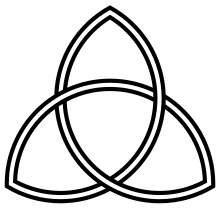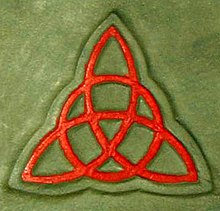Triquetra
This article needs additional citations for verification. (March 2010) |

Triquetra (/[invalid input: 'icon']traɪˈkwɛtrə/; Latin tri- "three" and quetrus "cornered") originally meant "triangle" and was used to refer to various three-cornered shapes. Nowadays, it has come to refer exclusively to a particular more complicated shape formed of three vesicae piscis, sometimes with an added circle in or around it. This has been used as a religious symbol of things and persons that are threefold.
Ancient usage
Germanic paganism
The triquetra has been found on runestones in Northern Europe and on early Germanic coins. It presumably had pagan religious meaning and it bears a resemblance to the Valknut, a symbol associated with Odin.
Celtic art
The triquetra is often found in Insular art, most notably metal work and in illuminated manuscripts like the Book of Kells. It is also found in similar artwork on Celtic crosses and slabs from the early Christian period. The fact that the triquetra rarely stood alone in medieval Celtic art has cast reasonable doubt on its use as a primary symbol of belief. In manuscripts it was used primarily as a space filler or ornament in much more complex compositions, and in knotwork panels it is a design motif integrated with other design elements. Celtic art lives on as both a living folk art tradition and through several revivals. This widely recognized knot has been used as a singular symbol for the past two centuries by Celtic Christians, Pagans and agnostics as a sign of special things and persons that are threefold.[1]
Christian use
The symbol has been used by Christians as a sign of the Blessed Trinity (Father, Son and Holy Spirit), especially since the Celtic Revival of the 19th century. When modern designers began to display the triquetra as a stand-alone design, it recalled the three-leafed shamrock which was similarly offered as a Trinity symbol by Saint Patrick. Some have also suggested that the triquetra has a similarity to the Christian Ιχθυς symbol. The triquetra has been used extensively on Christian sculpture, vestments, book arts and stained glass. It has been used on the title page and binding of some editions of the New King James Version.
A very common representation of the symbol is with a circle that goes through the three interconnected loops of the Triquetra. The circle emphasizes the unity of the whole combination of the three elements. It is also said to symbolize God's love around the Holy Trinity.
Modern use
In contemporary Ireland, It is traditional for a man to give a loved one a trinket such as a necklace or ring signifying his affection towards her. It is believed to represent the three promises of a relationship such as to love, honour, and protect. It is common for the design of the Trinity Knot to be engraved on a wedding ring and attaches to a Claddagh ring[2](another Irish traditional ring given for friendship or engagement).
Neopaganism
The Trinity Knot holds major significance in neopaganism in that it is believed to represent the three stages of the Triple Goddess (Maiden, Mother, and Crone).[3]

Modern Pagans use the triquetra to symbolize a variety of concepts and mythological figures.
Germanic Neopagan groups who use the triquetra to symbolize their faith generally believe it is originally of Norse and Germanic origins. Due to its presence in insular Celtic art, Celtic Reconstructionist Pagans use the triquetra either to represent one of the various triplicities in their cosmology and theology (such as the tripartite division of the world into the realms of Land, Sea and Sky),[4] or as a symbol of one of the specific triple Goddesses, for example, The Morrígan.
The symbol is also sometimes used by Neo-wiccans and some New Agers to symbolize either the Triple Goddess; or the Three Realms: Earth, sky and sea; or the interconnected parts of our existence (Mind, Body, and Soul).
Also the triquetra is a symbol of protection in the Neo-wiccan religion.[5] It is also said to represent family; Father, Mother and Child[citation needed]. However, this is not a traditional or mainsteam Wiccan idea. Wicca is primarily duotheistic - worshiping both a feminine Goddess and a masculine God - and does not include the concept of a divine child except at the winter solstice, when the God is seen as reborn from the Goddess. Within Wicca, the triquetra is mainly used as a symbol of the Triple Goddess of the Moon and Fate.
It is difficult to date the exact origin of the Celtic triquetra, and whether it was first used in a Christian or pagan context; the distinctive interlace/knotwork artistic style did not fully develop until ca. the 7th century A.D., but the triquetra is the simplest possible knot.
Popular culture
- The triquetra is often used artistically as a design element when Celtic knotwork is used. Many who identify as Modern Celts may use the symbol to display an identification with Celtic culture, whether they live in the Celtic Nations or the diaspora.
- In recent years, the symbol has become well-known due to its use on the cover of the "Book of Shadows" used by the three sisters on the American TV show Charmed. It represents the three sister witches working together as one.
- A triquetra is one of the four symbols on the cover of Led Zeppelin's fourth album, where it used as the personal symbol of bassist John Paul Jones.
- The triquetra is part of The Script's trademark symbol, which also features the science symbol. Together they make the symbol of science and faith, which relates to their second album, "Science and Faith" which is also the name of one of their songs.
- The band Payable on Death (P.O.D.) uses this symbol on most of their CD covers.
- The double triquetra is used to represent the Trinity on The New King James Version Bibles, published by Thomas Nelson, Inc.
- A necklace with a triquetra (Trinity Knot) pendant is used in the film Constantine giving its bearer what was described as being like a bulletproof vest, in the spiritual sense.
- A triquetra is seen on the floor of the laboratory, among other symbols, at the end of the video game Assassin's Creed.
- The TNA clothing brand, exclusive to Aritzia, has a logo composed of three triquetras.
- Game developers Treyarch use the triquetra as their company logo.
- In the motion picture Thor a triquetra symbol is displayed on Thor's hammer Mjollnir in response to incantations and other magical stimuli.
- The triquetra is often compared to the triforce in the Legend of Zelda video game series.
- The triquetra symbol was featured in the Ghost Whisperer season five episode "Lethal Combination".
- Michonne's katana in the TV series The Walking Dead features a triquetra.
Geometry
Topologically, the interlaced form of the plain triquetra is a trefoil knot.
Gallery of variant forms
-
Triquetra composed exactly of three overlapping Vesica piscis symbols.
-
An interlaced double Triquetra.
-
Tightly-knotted form of triquetra.
-
Triquetra interlaced with circle as Christian Trinitarian symbol (a "Trinity knot").
-
Triquetra in blue as part of an interlaced Christian Trinitarian decorative symbol.
-
The cross of triquetras or "Carolingian Cross".
-
Triquetra on one of the Funbo Runestones, located in the park of Uppsala University.
-
Close-up of a triquetra on one of the Funbo Runestones.
Literature
- Hallvard Trætteberg: «Triquetra», article in the Scandinavian encyclopedia Kulturhistorisk leksikon for nordisk middelalder, vol. 18, p. 634-635
- Martin Blindheim: Graffiti in Norwegian stave churches c. 1150 – c. 1350, Oslo 1985, i.a. p. 44-45
See also
References
- ^ In Search of Meaning, Dalriada Magazine 2001, http://www.celtarts.com/in_search_of_meaning.htm
- ^ McMahon, S. (1999). Story of the Claddagh Ring, Mercier Press
- ^ Conway, D.J. (1995). Maiden, Mother, Crone: the Myth and Reality of the Triple Goddess, Llewellyn Publications
- ^ Mac Mathúna, Liam (1999) "Irish Perceptions of the Cosmos" Celtica vol. 23 (1999), pp.174–187
- ^ Cunningham, Scott (2004) [1988], "Rune Magic", Wicca: A Guide to the Solitary Practitioner, Woodbury, MN, U.S.A.: Llewellyn, p. 191, ISBN 978-0-87542-118-6








